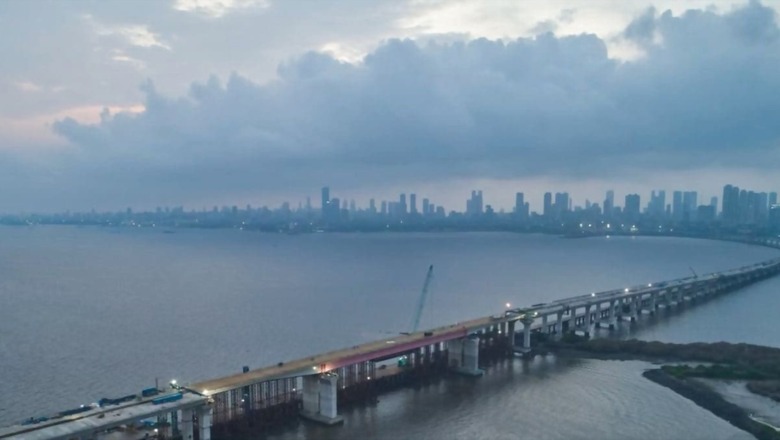
views
The Mumbai Trans Harbour Link Road, the longest sea link in India, is nearing completion, and will likely be open to the public by November this year. It was inspected by Maharashtra chief minister Eknath Shinde and deputy chief minister Devendra Fadnavis on Wednesday evening. They also went on a drive on the sea link.
While Fadnavis called it “the economic corridor”, CM Shinde termed it “a game changer for not just Mumbai, but for the entire Mumbai Metropolitan Region”. “MTHL will lay the foundation of a new megapolis in the vicinity of Mumbai and Navi Mumbai that would play an important role in boosting the state’s economy,” he said.
Several novel technologies have been used for the construction of the MTHL, making it an engineering marvel. Many of these technologies have been used in India for the first time. From environmental concerns to shipping corridors, everything was taken into consideration during the construction. The current physical progress of the project is about 94 per cent and the financial progress of the project is about 93 per cent. “A specialised and challenging work is getting completed,” an MMRDA spokesperson said.
Here’s what makes MTHL an engineering marvel with many firsts in India:
MTHL connects Mumbai to the mainland: It starts from Sewri in Mumbai to Chirle in Navi Mumbai. The 22-km-long sea link is the longest in the country and the tenth longest in the world. The project cost is Rs 17,843 crore.
MTHL a 6-lane bridge with 16.5 km construction on sea and 5.5 km on land: The bridge has interchanges at Sewri, Shivajinagar, and NH-48 near Chirle in Navi Mumbai. It will reduce the travel time from Mumbai to Navi Mumbai from 1.5 hours to 20 minutes.
Use of Orthotropic Steel Deck technology for the first time in India: This is an extremely crucial feature. The sea link passes through one of the busiest navigational channels leading to Nhava Sheva Port. And that is why it was important to build a sea bridge that will help facilitate the movement of merchant vessels. Orthotropic Steel Decks are special steel decks that enable a span (distance between two piers) that is up to three times longer than the norm. These have been used in stretches that are navigational channels for large ships. 70 long spans consisting of Orthotropic Steel Decks have been installed in the MTHL. Each has a different span length – varying from 65 metres to 180 metres. If you take a close look at the sea bridge, you will realise that not just the distance between the two piers, but also the height of the bridge is uneven at different locations.
Reverse Circulation Drilling: This is the first time this technology was used in India. This is used for laying the pile foundation. Usually, a vertical drilling method is used to lay a pile foundation. This creates a lot of noise, disturbing the surroundings. This was one of the major reasons for environmentalists to oppose the project as Sewri mudflats are one of the few sites where migratory birds including flamingoes have been coming in large numbers for years. Instead, Reverse Circulation Technology has made a difference, says MMRDA. It has been claimed that the number of flamingoes coming to Sewri mudflats has shown an increase despite the construction activity.
High Containment Crash Barriers: MMRDA plans to use these on the MTHL. These are special crash barriers that will push the car back on the road in case of a crash. Normal crash barriers only take the impact of a crash.
Total weight of OSD steel used in project (about 85,000 MT): It is equivalent to the weight of 500 Boeing 747s.
Total weight of reinforcement steel used (about 1,70,000 MT): It is equivalent to 17 times the weight of the Eiffel Tower.
Total length of PT strands used (close to 48,000 km): It is around four times the Earth’s diameter.
Concrete used in MTHL (about 9,75,000 m3): It is nearly six times the amount used in the Statue of Unity.
Total length of pile liner used (30 km): It is equal to 35 times the height of the Burj Khalifa.
MTHL will achieve:
- Physical and economic development of Navi Mumbai and Raigad district
- Faster connectivity with the proposed Navi Mumbai International Airport
- Faster connectivity of Mumbai Port and Jawaharlal Nehru Port
- Saving in fuel, saving in travel time by about 1 hour due to reduction of distance of about 15 km between Mumbai and Navi Mumbai, Mumbai-Pune Expressway, Mumbai-Goa highway
- Help decongest traffic in Mumbai city
















Comments
0 comment